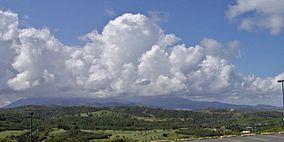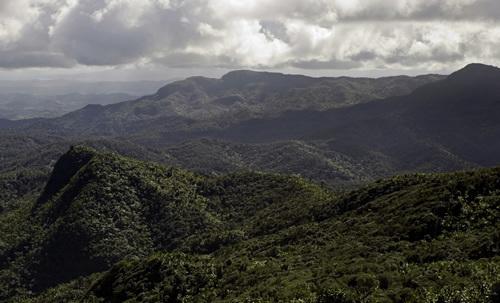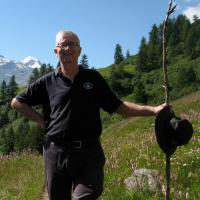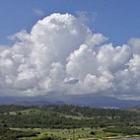When the United States acquired formal colonies in the Philippines and Puerto Rico after the Spanish-American War of 1898, it developed its first serious encounter with tropical forests as part of the construction of US conservation policy. The creation of national parks was not at the forefront of US concerns in the islands. Rather, the government scouted for likely sources of timber for commercial development, and to conserve forest areas to prevent future world timber famines.

Distant view of El Yunque National Forest. The mountain was said to resemble a blacksmith’s anvil.
Distant view of El Yunque National Forest. The mountain was said to resemble a blacksmith’s anvil.
Photo by Stan Shebs, 2004
Click here to view Wikimedia source.
 This work is licensed under a Creative Commons Attribution-ShareAlike 3.0 Unported License.
This work is licensed under a Creative Commons Attribution-ShareAlike 3.0 Unported License.

El Toro Wilderness is the core of the park as traversed by John Gifford in 1903.
El Toro Wilderness is the core of the park as traversed by John Gifford in 1903.
Photo by the US Forest service, 2006
Click here to view Wikimedia source.
 This work is licensed under a Creative Commons Public Domain Mark 1.0 License.
This work is licensed under a Creative Commons Public Domain Mark 1.0 License.
A little known phase of this work was the investigation of the Luquillo forest reserve in Puerto Rico, established in 1876 by the Spanish. Before 1916, no unified US national park system existed. The boundaries between the definitions of parks and forest reserves were still being set. The island empire, with its colonial “subjects,” facilitated emphasis on multiple-use and scientifically managed forests, whereas Hawaiʻi, an incorporated territory with US citizenship, achieved a national park in 1916.

An effusive press report of Gifford’s trip
An effusive press report of Gifford’s trip
New York Tribune, 21 September 1903, p. 3
Made available by the Chronicling America project of the Library of Congress.
Click here to view Chronicling America source.
 This work is licensed under a Creative Commons Public Domain Mark 1.0 License.
This work is licensed under a Creative Commons Public Domain Mark 1.0 License.
An obscure figure in American forestry policy, John Clayton Gifford became an advisor on the use and preservation of the Luquillo forest. Gifford is significant because of his role in the multinational transference of forestry knowledge between the continental United States, Germany, the colonial dependency of Puerto Rico, and other American spheres of Caribbean influence. Born in New Jersey in 1869, Gifford studied in Germany, the home of scientific forestry policy, graduating from the University of Munich in 1899 with a PhD in forestry. Having taught at Cornell University’s forestry school until 1903, he then worked for the Bureau of Forestry in the US Department of Agriculture as an agent from 1903 to 1906. As part of this work, Gifford submitted a report in 1904 of a survey undertaken the previous September into the forests of “Porto Rico.” This covered the rugged El Yunque Range in the eastern part of Puerto Rico. Newspapers hailed the report because it might lead to the creation of the “first national tropical park” in the United States park portfolio; they effused about the reserve as evidence of the tropical “wonders of Porto Rico.” It became a state-regulated space as part of US national and imperial development to be defined by the conservationist criteria of efficiency. But the US Government did not consider national park status appropriate for its colonies, despite the identification in US historiography of the US as the originator of the national park idea (America’s “best idea”). Bearing in mind his superiors’ inclination towards utilitarian forestry rather than official national park creation, Gifford recommended that the Luquillo forest remain reserved for timber use. It became the Caribbean National Forest in 1935, and in 2007 the name was changed to El Yunque National Forest to better represent the sentiments of the Puerto Rican people.
Gifford’s report shows a mixture of functions that American forestry officials hoped that the forests in the new colonies would fulfill. Gifford favored a multiple-use strategy in keeping with Progressive Era conservation’s utilitarian approach, but the reserve “should also be made accessible to the public for its scenic attractions.” Gifford saw no incompatibility between preservation and utilization for a variety of purposes, including those akin to a modern national park. Underlying Gifford’s thinking was the need to study all of the nation’s newly acquired tropical forest resources, generate cooperative research across the colonial system, and network with other imperial powers to improve tropical forest knowledge. He urged creation of a “center of forestry” with “educational value.” In 1907 President Theodore Roosevelt made the area the Luquillo National Forest, the first US national tropical forest reserve. Luquillo became valuable for transnational research and exchanges of information on tropical plants, but it was not until 1939 that an official Tropical Forest Experiment Station was established.

Photographs then and now emphasized the lush tropical greenery and the prevalence of natural “wonders” such as waterfalls and tall trees.
Photographs then and now emphasized the lush tropical greenery and the prevalence of natural “wonders” such as waterfalls and tall trees.
Photo by andrewm123, 2012
Click here to view Flickr source.
 This work is licensed under a Creative Commons Attribution-NoDerivs 2.0 Generic License.
This work is licensed under a Creative Commons Attribution-NoDerivs 2.0 Generic License.
Gifford used his Puerto Rican experience to advocate importing tropical plants to make southern Florida a center of forest production. This was unrealistic, since only the Caribbean islands, not Florida, were truly frost-free. Ominous, however, was Gifford’s advocacy of Australian melaleucas to soak up southern Florida’s swamps to create farms and real estate. He was an early advocate of draining and canalizing these areas he called “muck lands”. Though “scientifically” trained, Gifford recalled the nineteenth-century acclimatization movement’s ideas of an abundant garden landscape, in which the world’s plants would be experimentally mixed for both productivity and aesthetic appeal, and where land should be “improved” rather than preserved. In this respect his work was old-fashioned. But his respect for the earth’s life support systems (“Living by the Land”), and research into tropical forestry for sustainable use globally, looked very much to the future.
How to cite
Tyrrell, Ian. “Conservation and Forestry in the American Tropics: John Clayton Gifford in Puerto Rico.” Environment & Society Portal, Arcadia (2015), no. 10. Rachel Carson Center for Environment and Society. https://doi.org/10.5282/rcc/7042.
ISSN 2199-3408
Environment & Society Portal, Arcadia
 This work is licensed under a Creative Commons Attribution-NonCommercial-ShareAlike 4.0 International License.
This work is licensed under a Creative Commons Attribution-NonCommercial-ShareAlike 4.0 International License.
2015 Ian Tyrrell
This refers only to the text and does not include any image rights.
Please click on the images to view their individual rights status.
- Brinkley, Douglas. The Wilderness Warrior: Theodore Roosevelt and the Crusade for America. New York: HarperCollins, 2009.
- Gifford, John C. On Preserving Tropical Florida. Coral Gables: University of Miami Press, 1972.
- Gifford, John C. “A Porto Rico Forest Reserve.” Forestry and Irrigation, no. 11 (January 1905): 38–40.
- Gifford, John C. The Luquillo Forest Reserve, Porto Rico. Washington, D.C.: U.S. Dept. of Agriculture, Bureau of Forestry, 1905.
- Grunwald, Michael. The Swamp: The Everglades, Florida, and the Politics of Paradise. New York: Simon & Schuster, 2006.
- Troetschel, Henry Jr. “John Clayton Gifford: An Appreciation.” Tequesta, no. 10 (1950): 35–47.








